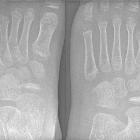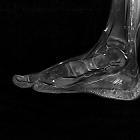Köhler disease














Köhler disease is an eponymous term referring to childhood-onset osteonecrosis of the navicular bone in the foot. Mueller Weiss syndrome is the adult counterpart of navicular bone osteonecrosis .
Epidemiology
It typically presents in the pediatric population (4-6 years of age) and there is a recognized male predilection.
Pathology
Although the etiology remains unknown, a vascular incident is suspected. Delayed bone age has also been noted in some cases and may play a part in the pathogenesis of this entity.
Radiographic features
Plain radiograph
- navicular may appear wafer-like (thinned) and fragmented
- demonstrates patchy sclerosis (similar to osteonecrosis elsewhere)
- often associated soft tissue swelling
CT/MRI
Cross-sectional imaging is usually not required but may be necessary if pain persists or the diagnosis is not clear.
Treatment and prognosis
Köhler disease often tends to be self-limiting and heals spontaneously with reossification and reconstitution within a few years. Application of a below-knee weight-bearing cast may improve symptoms and is recommended, typically for 6-to-7 weeks.
History and etymology
It was first described in 1908 by Alban Köhler, a German radiologist (1874-1947) .
Differential diagnosis
Usually, there is little difficulty in making the diagnosis. If symptoms persist then tarsal coalition should be sought.
See also
Siehe auch:
- Aseptische Knochennekrose
- Tarsale Koalition
- Müller-Weiss-Syndrom
- navicular stress fracture
- avaskuläre Nekrose des Os scaphoideum
- Morbus Köhler-Albau
und weiter:

 Assoziationen und Differentialdiagnosen zu Morbus Köhler I:
Assoziationen und Differentialdiagnosen zu Morbus Köhler I:


